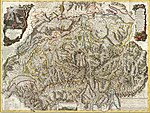
Back سويسرا الحديثة المبكرة Arabic המשטר הישן (שווייץ) HE Ancien Régime, Elveția Romanian Швейцария в раннее Новое время Russian Швейцарія в ранній новий період Ukrainian

| History of Switzerland |
|---|
 |
| Early history |
| Old Swiss Confederacy |
|
| Transitional period |
|
| Modern history |
|
| Timeline |
| Topical |
|
|
The early modern history of the Old Swiss Confederacy (Eidgenossenschaft, also known as the "Swiss Republic" or Republica Helvetiorum) and its constituent Thirteen Cantons encompasses the time of the Thirty Years' War (1618–1648) until the French invasion of 1798.
The early modern period was characterized by an increasingly aristocratic and oligarchic ruling class as well as frequent economic or religious revolts. This period came to be referred to as the Ancien Régime retrospectively, in post-Napoleonic Switzerland.
The loosely organized Confederation remained generally disorganized and crippled by the religious divisions created by the Swiss Reformation.[1] During this period the Confederation gained formal independence from the Holy Roman Empire with support from France, and had very close relations with France.
The early modern period also saw the growth of French-Swiss literature, and notable authors of the Age of Enlightenment such as the mathematicians of the Bernoulli family and Leonhard Euler of Basel.
- ^ Chisholm, Hugh, ed. (1911). . Encyclopædia Britannica. Vol. 26 (11th ed.). Cambridge University Press. p. 256.